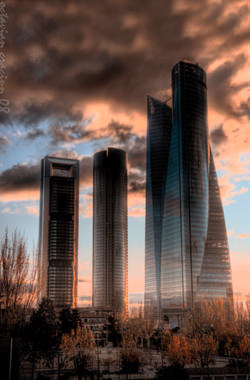Madrid is Spain's capital and by far the country's largest city. In Europe, only London and Berlin are larger in terms of population. Madrid is a modern city with a strong economy and a wonderful range of entertainment and attractions.
Entertainment Madrid
Madrid has a superior entertainment scene with something for even the most discerning visitor. For lunch and dinner, all the world's cuisines are represented and there are few cities in Europe that have as many Michelin restaurants as Madrid.
For evening and nocturnal pleasures, Madrid is a Mecca, and this just about every day of the week. Bars and pubs are on every street corner in most neighborhoods and nightclubs are numerous. Something special about the nightclubs in Madrid is that you don't always have to pay entry. Another aspect is that most self-respecting clubs don't open until midnight! The party goes on in most places all night, until the offices open in the morning. If you get up early and walk along the city streets, it is difficult to know who has just started their day, or who is about to end it...
Many Madrid residents like to walk around their city. These Madrileños like to walk along the city streets, the whole family including prams, even after midnight. In classic Spanish fashion, you chat with people, greet neighbors and have a tapas and a small beer at bar after bar after bar. Good places to experience the city include Gran Via (from Plaza de Callao to Plaza España), from Puerto del Sol to Plaza Mayor and down Calle del Arena, until you reach Plaza de Isabel II. Walk along the Calle de las Huertas pedestrian street from the Plaza Mayor to the Prado. Here you can also do some serious window shopping.
Note, you can find the cheapest accommodation in Madrid via Hotels.com. They have over 600 hotels in their range.
Sights Madrid
The Royal Palace Palacio Real is a popular attraction in Madrid. The castle is open to visitors and adjacent to it there are a couple of interesting museums to visit.
Puerta del Sol (Gate of the Sun) is the absolute center of Madrid and all of Spain (it is from here that the 0 kilometer mark of the Spanish road network is located). The square is a great landmark to aim for when exploring central Madrid. In the square there are a series of famous statues to take a closer look at.
The Museo del Prado is another must-see attraction. This museum houses some of the world's finest collections of art with works by, for example, Goya, Botticelli, Dürer and Rubens. The museum is located in the so-called museum triangle, which includes a handful of different museums.
If you have the opportunity, don't miss a visit to the Santiago Bernabéu football stadium. Watching a match together with over 80,000 other fans is an experience! The Galacticos have been a powerhouse in European football since the first superpower period began in the 50s.
When it comes to shopping, Madrid, as the metropolis it is, naturally has a huge selection. Gran Via is the main shopping street in the center. For a bit more quirky shopping, the area of Chueca and Fuencarral streets near the university can be recommended.
 Many miss the modern "Manhattan" part of the city. To take a tour along the skyscrapers, take bus number 27 from the Prado Museum. It heads north along Paseo del Prado, then turns onto Paseo de la Castellana before stopping at the glorious leaning towers of Puerta de Europa which is a sight in itself. The trip takes about 30 minutes. The metro back to the center takes about 20 minutes. Visit the area at sunset when it is at its most spectacular!
Many miss the modern "Manhattan" part of the city. To take a tour along the skyscrapers, take bus number 27 from the Prado Museum. It heads north along Paseo del Prado, then turns onto Paseo de la Castellana before stopping at the glorious leaning towers of Puerta de Europa which is a sight in itself. The trip takes about 30 minutes. The metro back to the center takes about 20 minutes. Visit the area at sunset when it is at its most spectacular!
To best experience the old part of Madrid, one of the tours offered with minibuses is recommended. Hop on at the Sevilla Metro Stop and get off at the terminus, which is the Embajadores metro. Along the journey, you see the best of what Madrid has to offer in terms of architecture - but also people, of course!
If you like a bit of a bohemian and trendy area, we recommend a trip to Lavapiés, which for a long time was the city's poorest and most deprived areas. Nowadays, it has attracted people from all over the world, cultural workers and businessmen. There are almost no tourists here either! In addition to lots of tapas bars, there are also many international cuisines represented here, mainly Indian restaurants.
Top-class Spanish
bullfighting Bullfighting is organized basically every day during the San Isidro festival in mid-May. Book well in advance.

